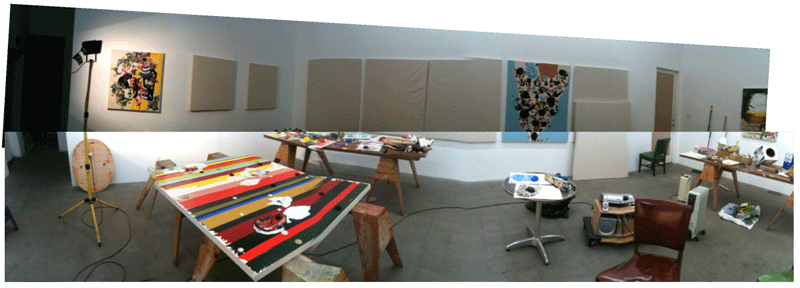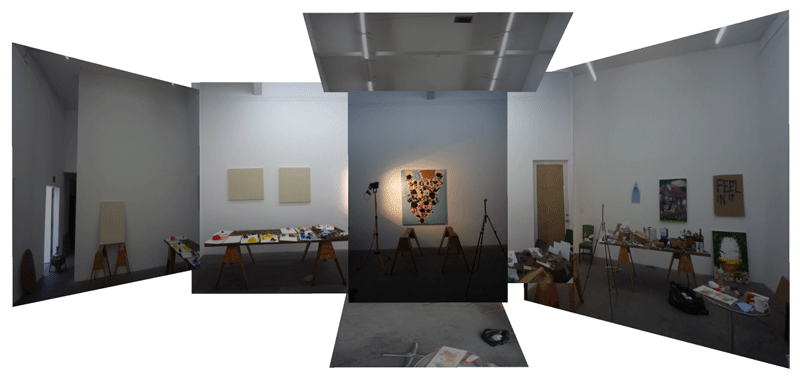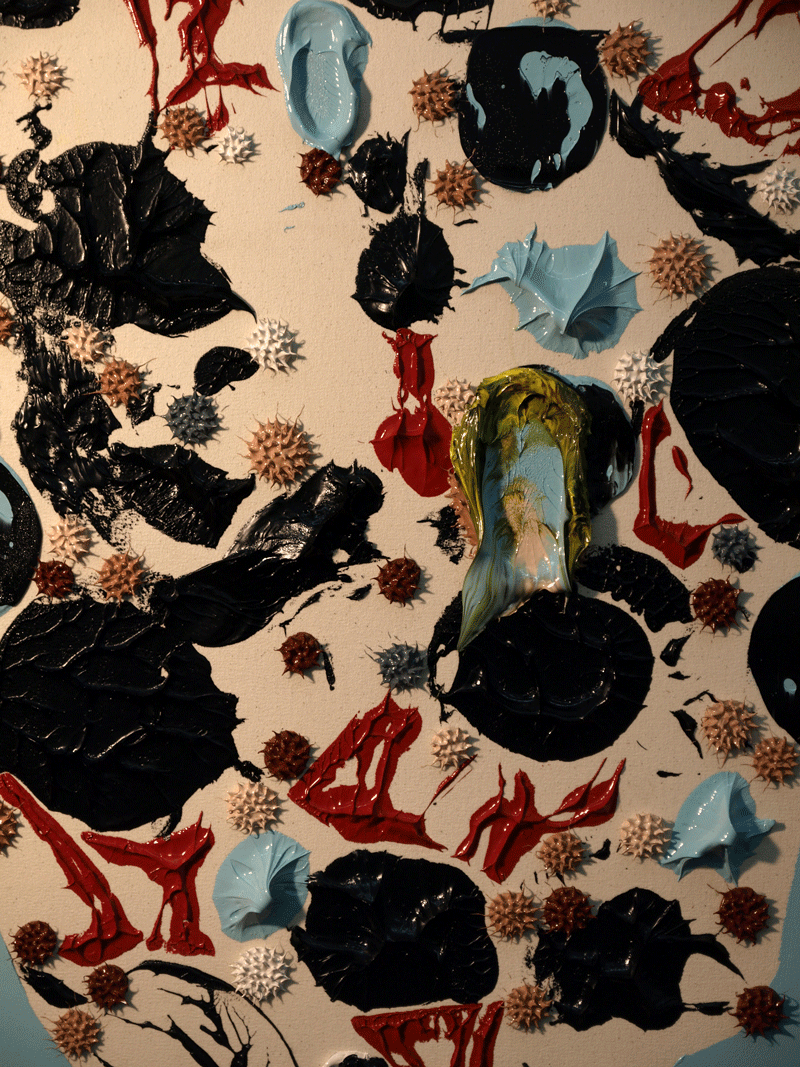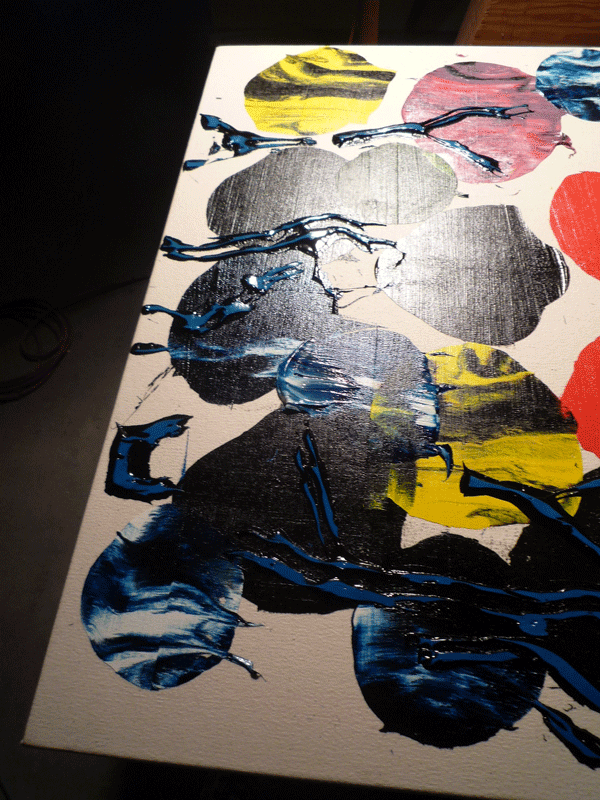November 26, 2010
November 19, 2010
Michael Kohn's 25th Anniversary
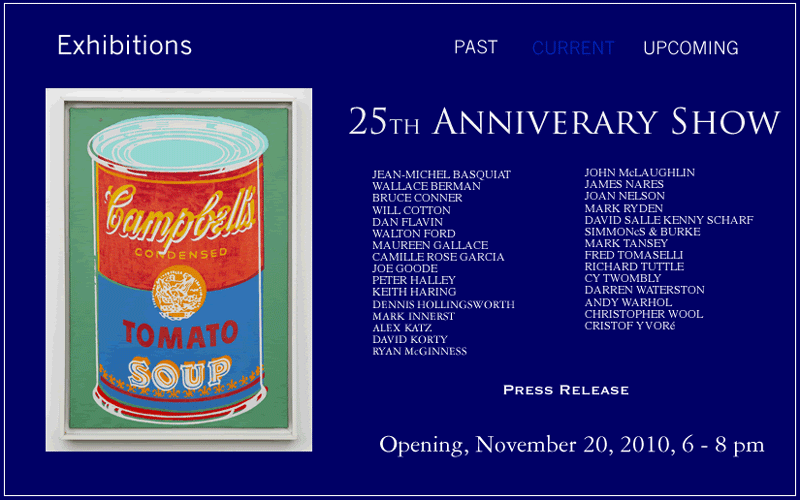
My gallerist in Los Angeles is having a show commemorating his 25th anniversary. Michael is a fascinating character whose history began as a writer/critic cum gallerist in New York, and transplanted to Los Angeles early in his career. Sharp, low key, perceptive, wry & amiable, independent... my ability to capture his character for this blogpost is limited, but you can come down to the opening tonight or to visit the gallery anytime thereafter to meet him and his staff in the flesh. Until then, I'll leave you with the gallery's press release, as follows:
?My dual interests in art history and contemporary art has always guided my curatorial efforts. The idea of present- ing artwork that is personally intriguing as well as challenging for the public has kept the gallery moving forward for a quarter century, and will continue for a long time to come. Los Angeles has grown enormously during this time and so has the Michael Kohn Gallery.? --Michael KohnThe Michael Kohn Gallery will celebrate its 25th anniversary with an important show of art- ists chosen from exhibitions over the last quarter century. Established in August of 1985, the Michael Kohn Gallery began its history with a show entitled New York?s Finest. This inaugural show brought to the West Coast a New York artistic sensibility that was inspired by Kohn?s years in Manhattan. Kohn returned to his native Los Angeles after five years in New York where he earned a Master?s Degree in Art History from NYU?s Institute of Fine Arts, and was U.S. editor of Flash Art magazine, Art & Auction contemporary art reporter and free-lance contemporary art critic.
For 25 years the Michael Kohn Gallery has mounted museum-quality exhibitions in Los Angeles of the work of Andy Warhol (during his lifetime), Richard Tuttle, Peter Halley, Keith Haring, Mark Tansey, Dan Flavin, John McLaughlin, Kenny Scharf, Maureen Gallace, Christopher Wool, among many other notable and talented artists. Michael Kohn Gallery also has the privilege of represent- ing the Estates of Wallace Berman and Bruce Conner, both important California-based artists whose work, from the 1950s and throughout their career, paralleled and led to notable developments in late 20th-century art.
The Michael Kohn Gallery has worked to create shows that have art historical importance, including one of Andy Warhol?s last shows, Campbell?s Soup Boxes, in November of 1986, just weeks before the artist?s untimely death. Other shows have included new works by Christopher Wool, Richard Tuttle, Kenny Scharf and Keith Haring, finally leading up to Michael?s more recent shows such as She: Works by Richard Prince and Wallace Berman, as well as Bruce Conner: Work from the 1970?s, which was the inspiration for Bruce Conner?s first solo retrospective in Europe at the Kunsthalle Wien (Vienna) in 2010. These important shows represent the Michael Kohn Gallery?s aim to create meaningful contexts for artists that link them to the greater canon of art history.
The 25th Anniversary Show will bring together examples of artwork from many of the various artists whom Michael Kohn Gallery has had the honor of showing over the years. New work by artists Mark Ryden, Darren Waterston, Maureen Gallace, David Korty and Dennis Hollingsworth will be shown among rare examples of work by Jean-Michel Basquiat, Christopher Wool, Fred Tomaselli, Mark Tansey, and Peter Halley and others.
Always with an eye towards the future, the Michael Kohn Gallery will continue to mount bold exhibitions and nurture younger talent, blending historically important works of art with emerg- ing talent of the 21st Century.
For further inquiry, please contact Laura Sumser at laura@kohngallery.com, or Lindsey Schiff-Abrams at lsa424@gmail.com.
November 18, 2010
Pero antes de eso
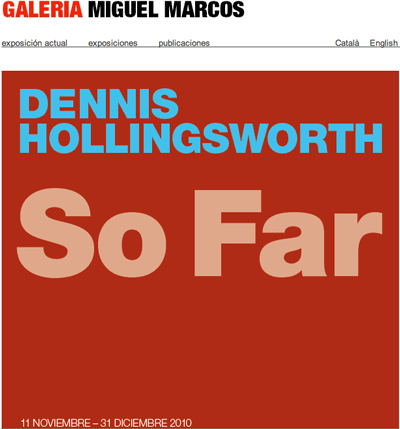
My gallery in Barcelona has posted a bit of text concerning the show that's up this month. My history is a bit complicated, and the challenge is how to describe it all succinctly. Miguel did a pretty good job, as far as my current capacity to fully comprehend spanish can tell.
"...que vive a caballo..." indeed:
Dennis Hollingsworth (Madrid, 1956) vivi? en Espa?a los tres primeros a?os de su vida, y fue aqu? tambi?n, frente a las pinturas de Goya del Museo del Prado, donde decidi? que quer?a dedicar su vida al arte. Pero antes de eso, supo que ten?a que experimentar vivencias que le permitieran tener algo que plasmar, as? que se enrol? en la Marina, viaj? por todo el mundo y se licenci? en arquitectura antes de estudiar bellas artes y dedicarse a su pasi?n, la pintura.Toda esta experiencia vital puede contemplarse en su obra. Su forma de pintar, utilizando la t?cnica alla prima, es a la vez intuitiva y met?dica. El cuadro est? perfectamente planificado antes de empezar a pintar, y al mismo tiempo, Hollingsworth improvisa sobre el dibujo inicial, consiguiendo un conjunto fresco, con una equilibrada composici?n llena de colorido.
Los grandes gruesos de ?leo que Hollingsworth aplica sobre el lienzo y las formas que ?l les da (sus ?erizos?, como han sido denominados) se han convertido en una de las caracter?sticas m?s importantes de la obra de este artista. El ?leo se convierte as? en un material carnoso, voluptuoso, org?nico y altamente sensual que alcanza pr?cticamente la categor?a de escultura.
En esta exposici?n, la tercera en la Galer?a Miguel Marcos desde que el galerista introdujo a Hollingsworth en Espa?a en 2006, muestra los trabajos realizados en verano de 2010. El artista, que vive a caballo entre la megal?polis de Los Angeles y la tranquilidad de un pueblecito en la Costa Brava, deja que lo mejor de cada cultura le invada y se plasme en sus lienzos; lienzos que nos remiten a cosas tan distintas como la monta?a, el fondo marino o la comida, permiti?ndonos ver el mundo interior del artista envuelto en todos los colores del arco iris.
November 17, 2010
November 16, 2010
November 15, 2010
Diana Sofia Estrada
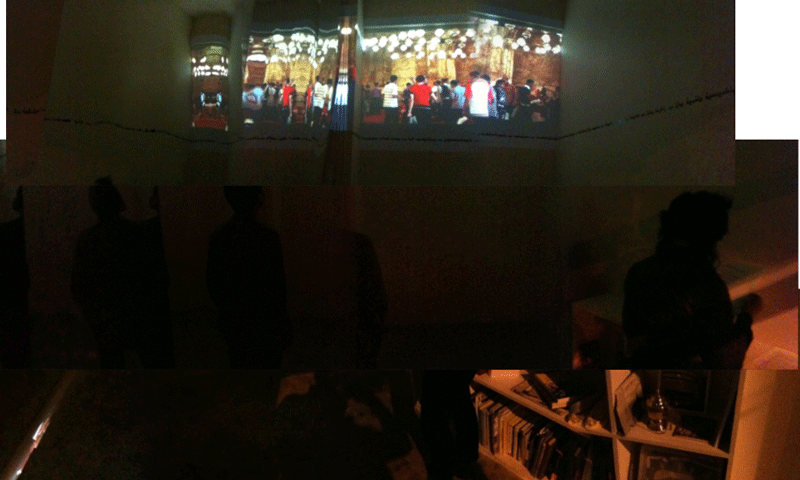
Around the corner the other night, opened Diana-Sofia Estrada's "Chandelier Mosque", curated by Aaron Wrinkle at Dan Graham, 506 Bernard St., Los Angeles from November 6th - November 20th.
Henry Next Door

Henry Taylor has moved into the studio space next door. He's getting ready for his upcoming solo show this spring at Blum & Poe, Los Angeles.
This panorama caught him in the act twice, Adam Janes stands to the right, observing the action.
Here's how he decorated his front door:

(Click on the foto for a closer look at his nom de guerre.)
November 12, 2010
CRYSTAL WORLD
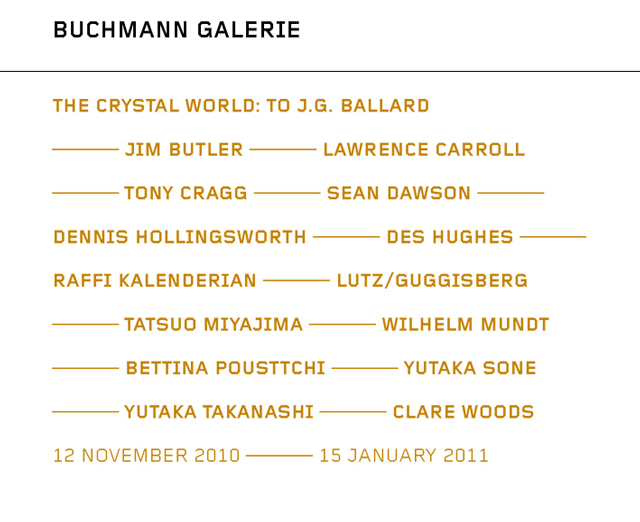
I'm honored to be included in CRYSTAL WORLD, an exhibition created by my gallery in Berlin, BUCHMANN GALERIE. Here is the press release:
Curated by Andr? BuchmannThe British writer J. G. Ballard (1930?2009) is the author of such great science fiction novels as The Drowned World, Crash, and Concrete Island. Many of his texts depict scenarios of the end of the world that do not describe the causes but only the events and the degeneration of society when faced with its end.
J. G. Ballard sketches a far less gloomy picture in his 1966 novel The Crystal World. A mysterious and dramatic biological change transforms plants, animals, and people in the jungle of Gabon into glowing crystalline structures; the novel?s real theme, however, is how the crystals transform time. One of the characters in the novel deliberately chooses to remain behind and crystallize in order to survive, avoiding death from an incurable disease.The exhibition brings together works by fifteen artists that are related in some way to this novel.
The artists Lutz/Guggisberg, who since 1996 have been working as a duo, have an unusual connection to literature through their imaginary library. As soon as we read the titles, authors? names, and publishers of their books, we imagine a story. With Lutz/Guggisberg?s books, the plot is created in the viewer?s imagination. Their books cannot be read; they trust in the power of the imagination.The Worm Returns is an early sculpture by Tony Cragg. As scientific visual aids, models of sulfur, polyethylene, and alcohol molecules help make a world visible that would otherwise escape visual perception. Do these models thereby result in a deeper understanding of our world?s objects and their inner structures? Sulfur molecules, for example, can form various crystal structures. Dr. Sanders, the protagonist of Ballard?s novel, is a scientist, and initially he seeks rational explanations for the continued crystallization and solidification of the jungle.
Wilhelm Mundt?s transparent glass sphere could also be an explanatory model for the crystal world. A massive layer of transparent glass surrounds like protective armor a red clump of material. Is it a meteorite providing clues about the origins of our earth and its ever crystallizing inner core of iron and nickel, or is it a biological pathogen that has caused the breakdown of time?
The two sculptures by Des Hughes also seem like fragments of a meteorite. Their matte surfaces contrast with golden intarsia from an unknown precious material or culture.
The crystallized jungle is declared a military restricted area, though it remains accessible at your own risk. The fragile and porous borders?understood in a political, social, and personal sense as well?are reflected in Bettina Pousttchi?s sculpture Cleared of transparent glass. The sculpture was presented at the Venice Biennale in 2009.
The fragile aspect of Bettina Pousttchi?s work is continued by Tatsuo Miyajima in his work about time, space, and primary colors (from which every other color can be produced). Diamond in You refers to the personal change in the protagonists of The Crystal World. In the end, Dr. Sanders does find himself, but he chooses the path into the crystallized, glowing jungle, and hence his death, like the blank space in Tatsuo Miyajima?s cyclical series of numbers.
Cautiously walking on tiptoes, the figure in Transparent Girl by Jim Butler dissolves in white light. The female body?is it Suzanne Clair of the novel??is now only a fragile shell that has already begun to mutate into a crystalline form. As a pendant to it, a painting by Raffi Kalenderian depicts a male protagonist with two pairs of eyes, representing inner and outer vision. Can he perceive the inconceivable?
Lawrence Carroll?s Snowballs recall the reliquaries covered with shimmering crystals that dealers pilfered from the solidified jungle to sell at the market in Port Matarre. In his photographs and drawings of snowflake crystals, Yutaka Sone turns an analytical eye on the inner structures of the glittering splendor that Yutaka Takanashi finds in 1970s Tokyo. His photographs from Towards the City reveal the megacity in all its facets. They are the summit of the Provoke movement, which in the late 1960s and early 1970s revolutionized Japanese photography with its raw, ephemeral, and expression manner.
J. G. Ballard was frequently a source of inspiration for pop musicians, such as Ultravox and Ian Curtis of Joy Division. Sean Dawson often refers to the novels of J. G. Ballard in the titles of his paintings. His dense, painterly compositions correspond to Ballard?s own dense language, making them thoroughly ?Ballardian.?
The jungle, with its prismatic colors, flickering lights, and flowing forms, is captured by Clare Woods in her watercolors and in the paintings of Dennis Hollingsworth, which recall microbiological and vegetal worlds with an inherent, ambiguous beauty.I would like to use this opportunity to thank sincerely all the artists for agreeing to participate, supporting, and providing works for this exhibition. In numerous conversations, I have found astonishing parallels between the works of the artists invited and J. G. Ballard?s novel.
A.B., October 2010
BUCHMANN GALERIE BERLIN
Charlottenstrasse 13
D - 10969 Berlin
T. +49-30-258 999 29
F. +49-30-258 999 39
info@buchmanngalerie.com
www.buchmanngalerie.com
Tue?- Sat 11am - 6pm
November 8, 2010
House for Aaron W.
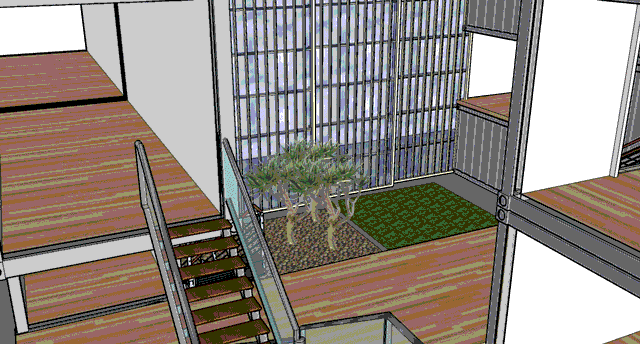
Stacked containers make a courtyard, walls of galleries to the sides, a living unit to the back. Trusses span overhead, curtain walls slide back as in aircraft hangers, just a little smaller.
First pass, rough sketch, pick and choose from a SketchUp database, form for a continued conversation.
(Recommended: listening to music while watching the animated gif. Somehow, the rotation moves to a beat. Don't know why, but it's pleasant. Unfrozen music.)
November 6, 2010
Matt Chambers at Untitled
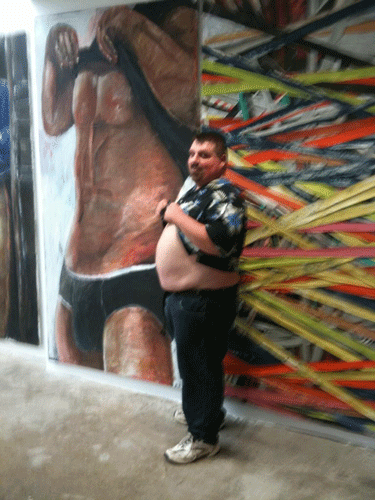
Longtime readers of this blog will remember Matt Chambers, local LA artist who is a longtime ChinaTown friend. Matt has an impressive show up at UNT/TLED, Joel Mesler and Carol Cohen's new space located at 30 Orchard Street in the Lower East Side of Manhattan.
Matt blew up the space with wall to wall paintings, folks outside of NY can find an extensive report in Contemporary Art Daily, and in the official UNT/TLED website.
Awesomeness.
Note: The man in the foto is not Matt Chambers. He's apparently an inspired, anonymous gallery visitor. Matt Chambers probably has washboard abs himself. All portraits are self portraits after all. However, the articulation of veins and the tone of the tanned skin is most likely self flattery if the portrait=self portrait theory is true. I'll ask him to lift his shirt next time we meet.
November 5, 2010
November 3, 2010
So Far
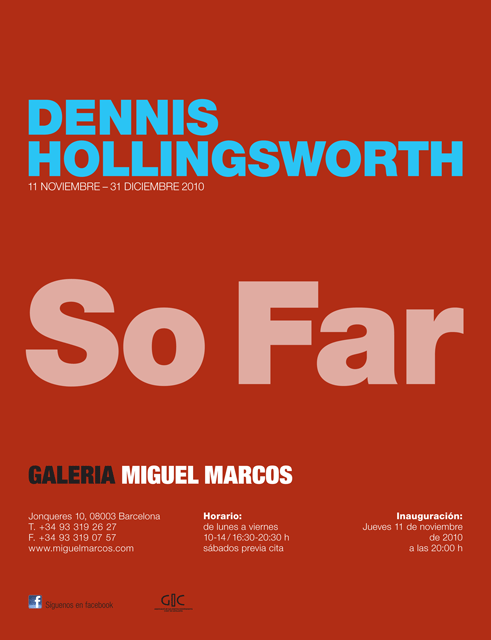
Miguel Marcos has been kind to put a show together in his gallery in Barcelona of the paintings I created in Tossa de Mar, Spain this past summer. The title So Far is derived as I do with a majority of my titles from the archives of this blog, chosen from the vicinity of the time in which the works were created. The words So Far has been a favorite of mine for some time. It suggests distance and longing, of time and space measured, an indication progress, a suggestion of the work I've done to date (as in "Recent Work" so common to painter's solo shows)...
At the beginning of the summer in Tossa, I asked a friend if So Far could be translated into tan lejos in spanish. He said "...yes, but it could mean so many other things." Good, I thought. Just what I was looking for.
Bernard Street Rotation
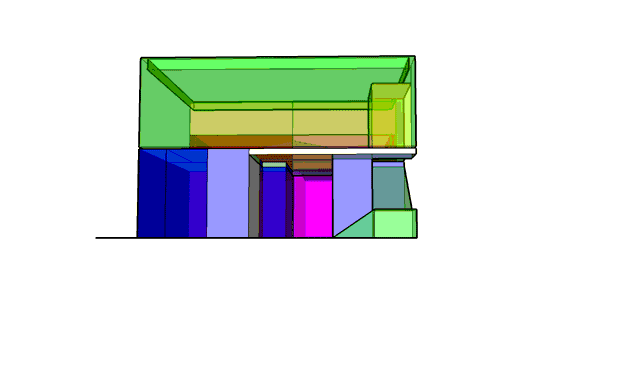
Legend:
Blue: WPA Gallery, a collective of 10-15 artists that alternates between solo shows and project based exhibitions.
Green: Currently available apartment, approx. 1200 s.f.*
Purple: Currently available studio, approx. 1200 s.f. *
Biege: 2nd Cannons, a publishing house/ Gallery.
Light Blue: Service spaces.
Red: My studio.
